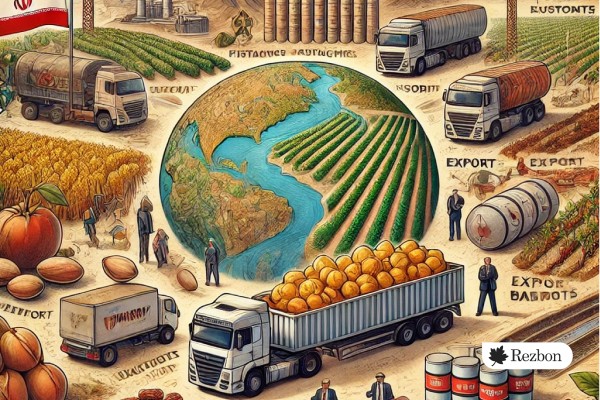Iran, with its diverse climate and fertile lands, has a strong foundation for producing a wide range of agricultural products. However, exporting these goods, particularly to international markets, presents several challenges. These challenges stem from internal inefficiencies, geopolitical issues, and global market demands. Below is a detailed look at the key challenges Iran faces in exporting its agricultural and food products.
1. Sanctions and Geopolitical Factors
One of the most significant obstacles Iran faces in the global marketplace is the international sanctions imposed by Western countries, especially the United States. These sanctions have led to restrictions on Iran’s ability to conduct international banking transactions, limiting access to the global financial system. This makes it difficult for exporters to receive payments or to use global trade mechanisms, often forcing them to rely on intermediaries or barter systems, which complicates and slows down the trade process.
2. Lack of Modern Agricultural Practices
Iran’s agricultural sector, while large and diverse, still heavily relies on traditional farming methods. Many farms lack modern equipment and infrastructure, resulting in lower productivity and product quality. The absence of efficient irrigation systems, modern harvesting equipment, and post-harvest technologies reduces the competitiveness of Iranian products in international markets. This inefficiency leads to higher costs of production, reducing profit margins and making it more challenging to compete globally.
3. Limited Access to International Markets
Iran’s agricultural products are in demand in many regions, particularly in neighboring countries and parts of Europe. However, access to these markets is often restricted by political factors, tariffs, and non-tariff barriers. For instance, many countries have stringent food safety regulations and phytosanitary standards, which Iranian exporters may struggle to meet due to a lack of infrastructure or modern testing facilities. This limits the ability to export perishable goods to high-demand markets such as the EU.
4. Logistics and Transportation Issues
The logistics and transportation infrastructure within Iran is another area of concern. Although the country has a strategic geographic location for trade, the transportation network, especially for agricultural products, is underdeveloped. Insufficient cold chain systems and inefficient port facilities lead to spoilage and wastage, particularly for perishable goods such as fruits and vegetables. Furthermore, road transport often suffers from poor conditions, increasing the cost and time needed to export goods.
5. Currency Fluctuations and Inflation
Iran’s economy has been plagued by currency instability and high inflation rates for several years. For exporters, this creates uncertainty in pricing and payment terms. The devaluation of the Iranian rial, while making exports cheaper in foreign currency, can lead to difficulties in covering production costs, which are often tied to international commodities and inputs like fertilizers and machinery. This economic volatility undermines the confidence of both exporters and foreign buyers.
6. Inadequate Packaging and Branding
A major factor in the success of agricultural exports is the ability to present products in a way that meets international market expectations. Iranian agricultural products often lack modern packaging and branding that appeals to global consumers. In competitive markets, particularly in Europe and North America, proper packaging can significantly affect a product’s marketability. Additionally, Iranian exporters may lack the knowledge or resources to meet the specific labeling requirements of different countries, which can result in rejected shipments or delays at customs.
7. Quality Control and Standardization Issues
Maintaining consistent quality is critical in agricultural exports. Many Iranian agricultural products lack the standardization needed for export, resulting in batches with varying levels of quality. This inconsistency can tarnish Iran’s reputation in international markets. Furthermore, the country lacks sufficient quality control infrastructure, such as accredited laboratories for testing pesticide residues or verifying organic labels, which limits access to high-value markets that require such certifications.
8. Water Scarcity and Environmental Challenges
Iran faces significant environmental challenges, particularly water scarcity, which has a direct impact on agricultural productivity. The overuse of water resources for irrigation, combined with prolonged droughts, has led to declining yields in many regions. This environmental strain makes it more difficult for farmers to sustain high levels of production, particularly for water-intensive crops like pistachios and saffron, two of Iran’s top agricultural exports.
9. Bureaucracy and Regulatory Hurdles
Domestic bureaucratic inefficiencies and excessive regulation also hinder Iran’s agricultural exports. Exporters must navigate a complex web of permits, certifications, and governmental oversight, which often results in delays. The lack of a streamlined export process increases costs and frustrates exporters, who may miss important shipping windows or face additional fees for extended storage at ports.
10. Competition from Other Countries
Iran is not the only country producing key agricultural products like saffron, dates, pistachios, and fruits. Major competitors such as Spain, Turkey, and Afghanistan have modernized their agricultural sectors, resulting in higher productivity and lower costs. Competing against countries with better technology, more efficient supply chains, and fewer political barriers makes it difficult for Iranian exporters to secure a stable foothold in international markets.
Conclusion
While Iran has significant potential to become a major player in the global agricultural market, it faces a multitude of challenges. Addressing these issues requires a combination of domestic reforms, investment in infrastructure, and better alignment with international standards. The government and private sector must work together to modernize farming techniques, improve quality control, and navigate the complex geopolitical landscape to fully realize Iran’s export potential in agriculture and food products.


